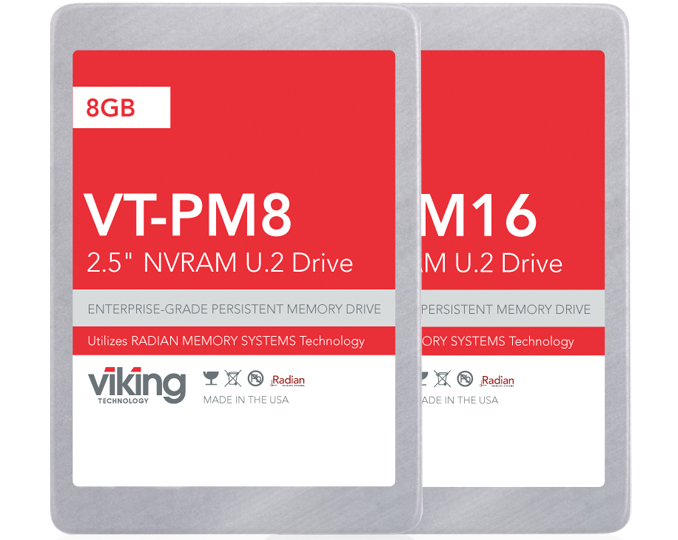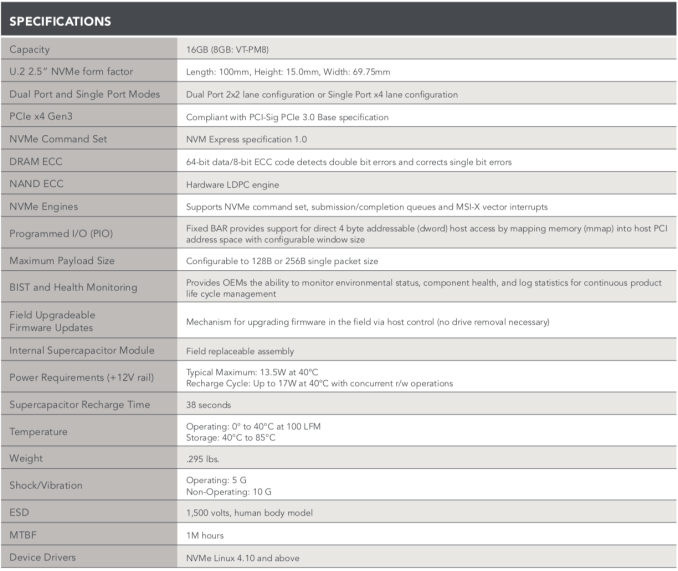Viking Launches VT-PM NVRAM U.2 Drives
by Anton Shilov on May 10, 2018 1:30 PM EST- Posted in
- SSDs
- Viking
- NVDIMM
- Radian Memory
- NVRAM

Viking Technology this week released its new VT-PM-series persistent memory drives that come in 2.5-inch U.2 form-factor and support hot-swapping capability. The drives are designed for applications that require a very high performance and an unlimited endurance, such as high-performance journalling and log storage for databases and filesystems. One of the key advantage of the drives when compared to regular NVDIMMs is support for hot-remove/surprise hot-add as well as an industry-standard interface.
Viking’s VT-PM8 and VT-PM16 persistent memory drives use the U.2 interface operating in dual port 2x2 or single port x4 mode. The storage solutions are equipped with 8 GB and 16 GB of DDR4-2400 RAM that has a virtually unlimited endurance (well beyond that of NAND or even 3D XPoint) as well as 8 GB and 16 GB of non-volatile NAND that is used to preserve data in the event of power failure. The SSDs are outfitted with an internal supercapacitor power source that kicks off automatically when the main power is lost to transfer data from DRAM to flash using the Flush-to-Flash firmware.
The drives are based on an architecture that can work with both DDR4 memory and NAND developed by Radian Memory Systems (it is unclear whether Radian uses an FPGA, or an ASIC). The architecture is fully compliant with the NVMe 1.0 command set that lets applications to access data on the VT-PM persistent memory drives via regular block or programmed I/O byte addressable access without any special requirements. To ensure data integrity, the silicon designed by Radian features a 64-bit data/8-bit ECC code to detect double bit errors and correct single bit errors in DRAM. Furthermore, the solution supports LDPC to ensure strong endurance and high performance of flash. In addition, Viking’s VT-PM drives support BIST (built-in self-test) that monitors components health and environmental status and then reports results to host systems.
When it comes to performance, Viking’s VT-PM drives should be pretty fast due to a PCIe 3.0 x4 interface (supports 32 Gb/s ‘raw’ bandwidth) and usage of relatively fast DDR4 DRAM. As for power consumption, the drives need up to 13.5 W when operating as well as 17 W when recharging the supercapacitor (a process that takes 38 seconds).
Viking’s VT-PM persistent memory drives are expected to be available shortly at prices that are up to negotiations.
Related Reading:
Source: Viking Technology











8 Comments
View All Comments
Dragonstongue - Thursday, May 10, 2018 - link
wonder the write endurance and the cost/capacities available, the temperature limit is not very good IMO and the wattage is similar not very good, but performance wise should be.I wonder the read/write and IOPS let alone the pricing.....seems more and more ultra high performance SSD types come out but equally high $ per gb instead of finding a happy medium ground for "good enough performance and encroaching on the HDD cost per gb advantage currently enjoyed"
$0.30c per gb or so is "not bad" but when they are going up against $.14 per gb or worse they have a way to go ^.^
I want to see an SSD at 1tb or better for $200 including ship and tax for Canada (basically double the speed double the price makes sense to me better than current 2x the speed 1/2 the capacity for 2.25x or more price) ^.^
jemmos - Thursday, May 10, 2018 - link
It's regular ddr4 memory with battery (supercap) backup. As such it's endurance is basically unlimited, and iops cease to matter as your limmited by the m.2 interface, and not the rams 1 million pluss iops limit. In short it's a hardware ram disk on a m.2 slot.Santoval - Friday, May 11, 2018 - link
U.2 interface actually, but the IOPS limits should be similar if not identical to M.2.fazalmajid - Friday, May 11, 2018 - link
Not sure about Canadian prices but the 2TB Micron 1100 SATA SSD is very attractive at USD 310.The Viking drive, like the DDRdrive before it, is meant primarily to use as a write log device for filesystems like ZFS that support this.
p1esk - Thursday, May 10, 2018 - link
What are "regular NVDIMMs"?How are these related to the NVDIMMs based on XPoint memory that Intel plans to release next year?
Santoval - Friday, May 11, 2018 - link
Why such an extremely low capacity? Is this intended solely as a non volatile cache?Billy Tallis - Friday, May 11, 2018 - link
Capacity is low because DRAM is expensive and kinda power hungry in large quantities, and because log/journal drives don't need to be very large. The data stored on this kind of drive is expected to be very short-lived, becoming invalidated as soon as the transaction it is tracking is completed and fully written to traditional storage. It's not meant to be a general-purpose writeback cache for long-lived data.Tom Womack - Tuesday, May 15, 2018 - link
So why not use RAM on the server motherboard, and a UPS which can keep the server up for one minute?